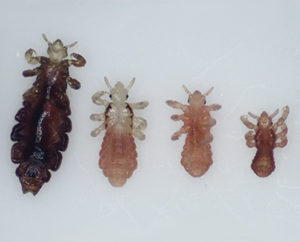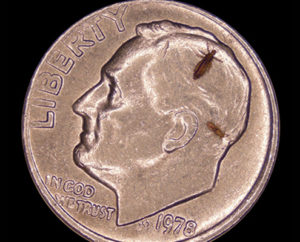Frequently Asked Questions
Look at the hair strands about a quarter inch (~0.5 cm) off the scalp. See if you can find lice eggs (often called nits) attached to individual hairs. Nits are extremely small. They look like tiny specks and will be glued pretty securely to the hair. If you see any, try pulling them off with your fingers. If you can’t easily pull them off, they are probably eggs and not dandruff.
The primary way you can get is when your head comes in direct contact with the head of an infested individual. Head-to-head contact like that doesn’t guarantee that the infestation will spread, but it gives lice the best opportunity to move from the hair of the infested person to your hair.
Head lice don’t jump or fly. Without strands of hair to grab with the claws on their legs, they have trouble getting around at all. However, they can crawl pretty quickly along the hair, so if your hair comes in contact with an infested head, it doesn’t take much for a louse to hitch a ride on a strand of your hair and make its way to your scalp.
Excluding the 7-10 days they spend as eggs, can live for around 30-35 days on your head. As parasites, they feed on human blood several times a day.
If they are removed from their food source – say from getting knocked out of your hair with a brush or your hand – they can survive 24-48 hours. If they don’t find some human hair to crawl back to a new host during that time, they will die.
Head lice do not survive long if they fall off a person and cannot feed. You don’t need to spend a lot of time or money on housecleaning activities. Follow these steps to help avoid re–infestation by lice that have recently fallen off the hair or crawled onto clothing or furniture.
- Machine wash and dry clothing, bed linens, and other items that the infested person wore or used during the 2 days before treatment using the hot water (130°F) laundry cycle and the high heat drying cycle. Clothing and items that are not washable can be dry–cleaned OR sealed in a trash bag for 48 hours.
- Soak combs and brushes in hot water (at least 130°F) for 5–10 minutes.
- Vacuum the floor and furniture, particularly where the infested person sat or lay. However, the risk of getting infested by a louse that has fallen onto a rug or carpet or furniture is very small. Head lice survive less than 1–2 days if they fall off a person and cannot feed; nits cannot hatch and usually die within a week if they are not kept at the same temperature as that found close to the human scalp. Spending much time and money on housecleaning activities is not necessary to avoid re-infestation by lice or nits that may have fallen off the head or crawled onto furniture or clothing.
- Do not use fumigant sprays; they can be toxic if inhaled or absorbed through the skin.
The first line of defense is to gather all linens and clothing that the child has been in contact within the last 48 hours. Place in dryer and dry 40 minutes on the highest heat setting.
There are many items that cannot be placed in the dryer, but must also be treated. Again, isolation is the best method for dealing with these items, including stuffed animals, pillows, helmets or headphones. You should expect these items to be out of commission for at least 48 hours. Thoroughly vacuum carpets, furniture, floors and cars.
Hair brushes and all hair accessories need to be placed in a zip lock baggie and placed in the freezer for 48 hours. Label all brushes so they are not shared. Do not share beds, pillows, or hats.
LICE
Although there are many types of lice, the head louse, or Pediculus humanus capitis, is a parasitic insect that can be found on the head and, more rarely, the eyebrows and eyelashes of people. Head lice (the plural form of louse) feed on human blood several times a day and live close to the scalp to maintain their body temperature.
LIFE CYCLE
Head lice come in three stages: egg, nymph and adult (learn how big lice are in their various stages). Eggs are often called lice nits, although many people refer to nits as the empty egg shells left behind by a hatched louse.
LICE HAVE CLAWS
A head louse has six claws that allow it to crawl around from hair strand to hair strand. It can move from one head to another this way, which is why head-to-head contact is the primary way head lice are spread between people.
HEAD TO HEAD
A head-lice infestation occurs when a female adult louse makes it onto a new head and lays eggs. When those eggs hatch, the lice will most likely stay on that head throughout the entire lice life cycle. Unless the head is treated (see pediculosis treatment) and all lice and eggs are eradicated, the lice infestation will continue for however long the lice can live.





